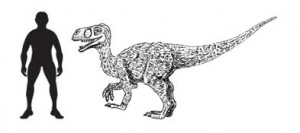Did Tyrannosaurus rex Live on the Isle of Wight?
T. rex on the Isle of Wight
An email received on Thursday afternoon sent our dinosaur experts scurrying away to find their compendiums detailing fossil discoveries related to the Wealden Formation in association with the Isle of Wight.
A school pupil had emailed with a query regarding whether it was true that ancestor of Tyrannosaurus rex lived in the Isle of Wight. The origins of the tyrannosaur family are very much open to debate. However, one member of this family is associated with the Isle of Wight, although whether is creature was a direct ancestor of T. rex remains in doubt.
The dinosaur in question is Eotyrannus (E. lengi), which is known from one, partial, disarticulated skeleton partly enclosed within a large siderite concretion (a lump of iron carbonate). The fossil was found in a plant debris bed (Wessex Formation) on the south-west coast of the island. The fossils have been dated to the Early Cretaceous (Barremian faunal stage), and although a juvenile, the animal is estimated to have been over 4 metres long when it died. Adult animals may have exceeded 6 metres or more.
A Scale Drawing of Eotyrannus (E. lengi)
Picture credit: Everything Dinosaur
This dinosaur has been classified as a basal (primitive) tyrannosauroid. The teeth are D-shaped in cross-section, characteristic of tyrannosaurs. The shape of the snout, the fused nasal bones plus similarities seen in the fossilised humerus (upper arm bone) between this dinosaur and other known tyrannosaurs led scientists to conclude that Eotyrannus was indeed a tyrannosaur. The neck bones (cervical vertebrae) also suggest that this dinosaur was a tyrannosaur.
To view a model of Eotyrannus and other dinosaur replicas, take a look at the CollectA Age of Dinosaurs model range: CollectA Age of Dinosaurs Prehistoric Life Models.
Other fragmentary theropod fossils from the Isle of Wight have been ascribed to this genus. Although the rarity of these fossils may suggest that Eotyrannus was not a resident of the flood plains that the fossil strata of the Isle of Wight represent. Scientists have speculated that this predator stalked the upland areas and was a creature that preferred a woodland habitat. The long limbs and light-weight skeleton indicate an active hunter, this is why most illustrations of Eotyrannus depict this dinosaur with a coat of insulating primitive feathers.


